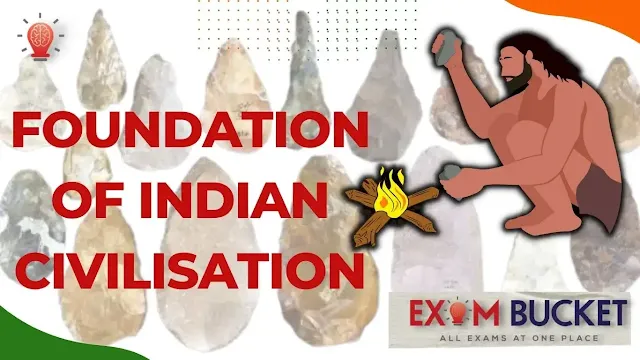Before the emergence of any civilization (Indus Valley Civilization) in the Indian subcontinent, there were prehistoric cultures and communities that inhabited the region during the Paleolithic Age, which began around 2.6 million years ago and ended around 10,000 BCE.
{tocify} $title={Table of Contents}
The Paleolithic Age in India can be divided into three phases:
the Lower Paleolithic (2.6 million years ago to 200,000 BCE),
the Middle Paleolithic (200,000 BCE to 30,000 BCE), and
the Upper Paleolithic (30,000 BCE to 10,000 BCE).
During the Lower Paleolithic period, early human ancestors such as Homo habilis and Homo erectus lived in India and used stone tools for hunting and gathering. The Middle Paleolithic period saw the emergence of Homo sapiens, who also used stone tools and began to live in more organized groups. The Upper Paleolithic period saw significant developments in human culture, including the use of fire, the development of more advanced stone tools, and the creation of art in the form of cave paintings and rock art.
These early human groups were nomadic and lived in small groups. They relied on hunting, fishing, and gathering wild plants for survival. The evidence of Paleolithic culture in India includes stone tools, cave paintings, and rock shelters, which have been discovered in various parts of the country.
The Paleolithic Age laid the foundation for human settlement in India and the development of later cultures and civilizations.
By the end of the fourth millenium BC India has emerged as a region of highly developed civilisation.
Before the Indus Valley Civilization, there were several other cultures and civilizations that existed in the Indian subcontinent, but their history is not well-documented.
One of the earliest known cultures in India is the Mehrgarh culture, which was a pre-Indus Valley Civilization culture that existed in present-day Balochistan, Pakistan, from around 7000 BCE to 2600 BCE. The Mehrgarh culture was an agricultural society that cultivated wheat, barley, and other crops and also domesticated animals such as sheep, goats, and cattle. They also traded with other regions, as evidenced by the discovery of materials such as lapis lazuli, seashells, and turquoise, which were not found in the local region.
Other early cultures in India include the Neolithic and Chalcolithic cultures, which existed between 7000 BCE and 2500 BCE, and the early Harappan culture, which was a precursor to the Indus Valley Civilization and existed between 3300 BCE and 2600 BCE. These cultures were characterized by the development of agriculture, domestication of animals, and the use of copper and bronze tools and weapons. However, much of their history remains shrouded in mystery, as their written records have not been deciphered.

